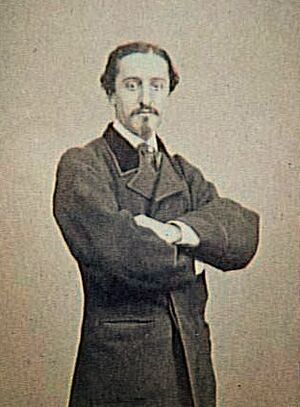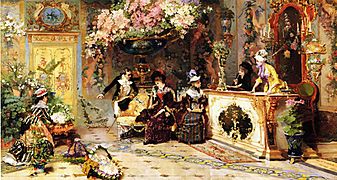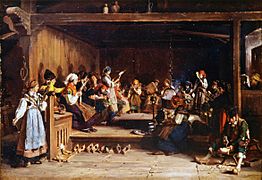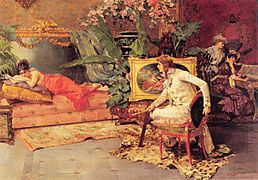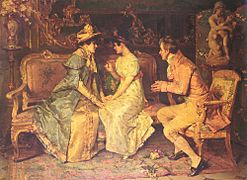Luis Álvarez Catalá facts for kids
Luis Álvarez Catalá (born January 22, 1836 – died October 4, 1901) was a Spanish painter. He was known for painting historical scenes. He also served as the Director of the famous Museo del Prado museum in Madrid from 1898 to 1901.
Contents
A Young Artist's Journey
Luis Álvarez Catalá was likely born in Madrid, Spain. His family came from a region called Asturias. He spent his summers there as a child. After finishing his first studies in Oviedo, he returned to Madrid. There, he joined the "Escuela Especial de Pintura, Escultura y Grabado." He also studied with a famous teacher, Federico de Madrazo, at the Real Academia de Bellas Artes de San Fernando.
In 1857, Luis won a special scholarship. This allowed him to study art in Rome, Italy. Other talented artists like Eduardo Rosales and Vicente Palmaroli also won scholarships. After four years in Rome, he won a Gold Medal. This was at the first National Exposition of Florence. His painting, Calpurnia's Dream, earned him this award. The same painting later won second place at the National Exhibition of Fine Arts in Spain in 1862. Queen Isabel II bought his painting. Because of this success, his scholarship was extended for three more years.
Life and Work in Rome
Luis got married while living in Rome. He stayed there until 1894, only visiting Madrid briefly. He continued to show his art in many places. He exhibited in Italy, Spain, and Germany. He won more awards in 1889 and 1890 for his paintings.
Becoming a Museum Director
Finally, Luis returned to Spain in 1894. He took on an important job. He became the Deputy Director at the Museo del Prado. Four years later, the Queen appointed him as the Director. This happened after the previous director, Francisco Pradilla, resigned. His new Deputy Director was Salvador Viniegra.
As Director, Luis made many important purchases for the museum. These included several artworks by the famous artist Francisco de Goya. In 1899, he created a special book. It was called Catálogo ilustrado de la sala de Velázquez. This book showed the museum's collection of works by Diego Velázquez. He also oversaw the installation of a statue of Velázquez. This statue was made by Aniceto Marinas.
Even as Director, Luis kept painting. He mostly created works in the costumbrista style. This style showed everyday life and customs. In his later years, he painted scenes inspired by his childhood in Northern Spain. Many of these paintings are now at the Museum of Fine Arts of Asturias. He passed away in Madrid.
Selected Works
-
The Filandón, a traditional evening gathering in León and Asturias
See also
 In Spanish: Luis Álvarez Catalá para niños
In Spanish: Luis Álvarez Catalá para niños


